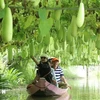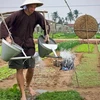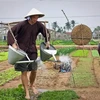Homestay accommodation and community-based tourism, which are developing rapidly in a number of localities throughout Vietnam, have substantially contributed to the promotion of the value of local cultures and poverty-reduction efforts.
Homestays first emerged in Sa Pa tourist town in Lao Cai and spread to other parts of the northern mountainous province. They have proven highly effective in the province, with 145,752 tourists choosing homestays in 2013, spending a total of 29 billion VND (1.36 million USD).
In staying with local residents, tourists can enjoy local specialties and traditional music performances and experience locals’ way of life. They can also take part in tours of the surrounding villages.
Hoi An, in central Quang Nam province, has also successfully developed community-based tourism in Tra Que vegetable village, which has become an attractive destination for tourists, especially international visitors.
Recognising the benefits of community-based tourism, local authorities have expanded the model to other areas and developed new services. Tourists can now explore nipa palm forests, cycle through peaceful villages, learn to cook and enjoy seafood specialties.
This kind of tourism first emerged in the Mekong Delta when the Ship for Southeast Asian Youth Programme anchored in Ho Chi Minh City in 1995. Fishing, harvesting fruits and visiting floating markets have since attracted a large number of domestic and foreign visitors.
According to a report published by the Vietnam National Administration of Tourism, the contribution of tourism to the economy increased significantly in recent years. In 2013, the total revenue from tourism reached 200 trillion VND (9.4 billion USD), accounting for approximately 6 percent of the country’s GDP.
Approximately 1.8 million people benefit from tourism, including more than 570,000 people directly employed in the sector.
Community-based tourism has accelerated the modernization process in rural areas, helping to reduce poverty and transform the economic structure. It has also changed local residents’ perception of tourism, narrowing the development gap between urban and rural areas and reducing the emigration rate from the countryside to major cities.-VNA
Homestays first emerged in Sa Pa tourist town in Lao Cai and spread to other parts of the northern mountainous province. They have proven highly effective in the province, with 145,752 tourists choosing homestays in 2013, spending a total of 29 billion VND (1.36 million USD).
In staying with local residents, tourists can enjoy local specialties and traditional music performances and experience locals’ way of life. They can also take part in tours of the surrounding villages.
Hoi An, in central Quang Nam province, has also successfully developed community-based tourism in Tra Que vegetable village, which has become an attractive destination for tourists, especially international visitors.
Recognising the benefits of community-based tourism, local authorities have expanded the model to other areas and developed new services. Tourists can now explore nipa palm forests, cycle through peaceful villages, learn to cook and enjoy seafood specialties.
This kind of tourism first emerged in the Mekong Delta when the Ship for Southeast Asian Youth Programme anchored in Ho Chi Minh City in 1995. Fishing, harvesting fruits and visiting floating markets have since attracted a large number of domestic and foreign visitors.
According to a report published by the Vietnam National Administration of Tourism, the contribution of tourism to the economy increased significantly in recent years. In 2013, the total revenue from tourism reached 200 trillion VND (9.4 billion USD), accounting for approximately 6 percent of the country’s GDP.
Approximately 1.8 million people benefit from tourism, including more than 570,000 people directly employed in the sector.
Community-based tourism has accelerated the modernization process in rural areas, helping to reduce poverty and transform the economic structure. It has also changed local residents’ perception of tourism, narrowing the development gap between urban and rural areas and reducing the emigration rate from the countryside to major cities.-VNA



















